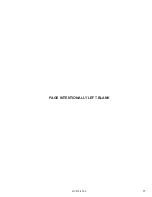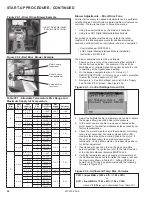
16
MCP15-500.9
HOT WATER PIPING CONNECTIONS
CAUTION
1. Units not approved for use in potable water systems.
2. Do not operate the unit with steam. The coil is not designed
for steam condensate removal which can damage the unit.
3. Hot water supplied to the hot water heating option must
not exceed 180°F temperature or 75 PSIG pressure.
Figure 16.2 - Typical 2-Way Piping Installation
(piping and components by others)
2-WAY CONTROL
VALVE
SHUT-OFF
VALVE
SHUT-OFF
AIR VENT
RETURN
SUPPLY
SETTER
CIRCUIT
VALVE
UNION
UNION
STRAINER
UNION
HOT WATER
COIL
HOSE BIB DRAIN
1. Models with a factory installed hot water heating coil (for use
with water or glycol fluids) are supplied with 1-1/2" sweat
connections (1.625").
2. The entering water temperature (EWT) supplied to the
heating coil must not exceed 180°F.
3. The fluid flow rate must not exceed 50 GPM and fluid
pressure must not exceed 75 psi.
4. It is recommended to use an inhibited glycol solution that is
designed for HVAC applications for corrosion protection and
freeeze protection for the lowest possible outside air
temperatures for the installed location. Failure to protect
against freezing can result in damage to the coil and
property.
5. Provide adequate pipe hangers, supports, or anchors to
secure the piping system independently of the coil to prevent
excess vibration and stress that can damage the piping and
joints.
6. All field brazing and welding should be performed using high
quality materials and an inert gas purge (such as nitrogen) to
reduce oxidation of the internal surface of the coil.
7. System piping should be flexible enough to allow for thermal
expansion and contraction of the coil and piping components.
8. Refer to Figures 16.2 and 16.3 for typical piping system
design and the following recommended items:
• Install shut-off valves in lines to and from the unit to allow
for maintenance or replacement of the coil without shutting
down and draining the entire system.
• Install unions for ease of piping component/coil removal.
• Include a circuit setter in the return line to regulate flow.
Figure 16.1 - Hot Water Coil Connections
Supply Connection
Return Connection
Optional Factory Installed Freeze Stat
When equipped with the optional Coil Freeze Stat, an auto-
resetting capillary type freeze stat (see Figure 56.1) is factory
installed immediately below and across the face of the hot
water coil. The stat is set to trip at 40°F (adjustable) and will
automatically reset when the coil temperature rises 5°F above
the setpoint. If the stat has tripped, the unit controls would
respond by closing the outdoor air damper, opening the return
air damper (if applicable), de-energize the supply air fan, open
the hot water coil valve 100%, and log the alarm on the
controller. The freeze stat can be removed from the unit for
servicing as discussed in the Maintenance section.
Figure 16.3 - Typical 3-Way Piping Installation
(piping and components by others)
3-WAY CONTROL
VALVE
SHUT-OFF
VALVE
SHUT-OFF
AIR VENT
RETURN
SUPPLY
SETTER
CIRCUIT
VALVE
BALANCING
VALVE
UNION
UNION
STRAINER
UNION
HOT WATER
COIL
UNION
HOSE BIB DRAIN
THIS SECTION APPLIES TO UNITS WITH
OPTIONAL HOT WATER HEAT
(MODEL DIGIT 17=4).
IF THE UNIT DOES NOT HAVE HOT
WATER HEAT, SKIP TO PAGE 18.
REVIEW BEFORE PROCEEDING
• On 3-way valve control configurations, include a balancing
valve between the supply line and control valve to balance
the system.
• Include a hose bib drain valve on the bottom of the supply
manifold to allow for periodic flushing of the system to
remove sediments from the coil.
• Include a pipe line strainer on the supply line to prevent
sediment from reaching the coil.
• Include an air vent at the top of the return manifold to bleed
off accumulated air in the system. Air in the system will
generate noise and may cause water hammer that can
damage the joints of the piping and coil.
• Include either a 2-way or 3-way modulating control valve
designed for a 0-10VDC control signal. The valves will be
automatically modulated by the unit’s Carel controller to
maintain the supply air temperature setpoint. Note that the
control valve must be a normally open, spring return type
valve. This is to allow hot water to flow through the coil for
freeze protection when the unit is shut down. Refer to the
Freeze Stat Option section below for additional detail.
• Hot water pipes should be insulated to reduce heat loss and
to prevent overheating of the end compartment.
9. Leak test the coil and connections as outlined in the
Start-Up section.
Содержание MPR Series
Страница 17: ...17 MCP15 500 9 PAGE INTENTIONALLY LEFT BLANK ...
Страница 67: ...67 MCP15 500 9 PAGE INTENTIONALLY LEFT BLANK ...
















































